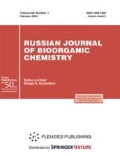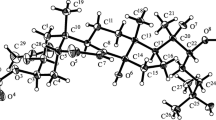Abstract—
The paper reports preparation of molecular complexes of cholesterol with dominant triterpene saponins from members of the ivy genus Hedera L. (Araliaceae Juss.), that is, monodesmosidic glycoside α-hederin (hederagenin 3-O-α-L-rhamnopyranosyl-(1→2)-O-α-L-arabinopyranoside) and bisdesmosidic glycoside hederasaponin C (hederagenin 3-O-α-L-rhamnopyranosyl-(1→2)-O-α-L-arabinopyranosyl-28-О-α-L-rhamnopyranosyl-(1→4)-О-β-D-glucopyranosyl-(1→6)-О-β-D-glucopyranoside), as well as with minor monodesmosidic glycoside hederoside F (hederagenin 3-О-β-D-glucopyranosyl-(1→2)-О-β-D-glucopyranoside). The complexation has been investigated by methods of isomolar series in the spectrophotometric version and FT-IR spectroscopy with a universal optical attenuated total reflection (ATR) accessory. It has been shown that α-hederin, hederasaponin C, and hederoside F form 1 : 1 complexes with cholesterol, having a stability constants (5.6 ± 0.1) × 104, (4.7 ± 0.1) × 104 and (6.0 ± 0.6) × 104 M–1, respectively (in 70% aqueous ethanol at 25°С). The constants are calculated on the basis of isomolar curves. The complexes of cholesterol with ivy monodesmosidic glycosides are more stable. Intermolecular interaction in the complexes is carried out by hydrogen bonds formation of type –С=О⋅⋅⋅Н–О– (for monodesmosidic glycosides) and –(Н)О⋅⋅⋅Н–О– (for bisdesmosidic glycoside). Hydrophobic contacts of the aglycone part of glycosides (hederagenin) with a lipophilic cholesterol molecule are possible. As a result, changes in some frequencies of the absorption bands of CH bonds are observed, which was established by IR-spectroscopy.





Similar content being viewed by others
REFERENCES
Hostettmann, K. and Marston, A., Saponins, Cambridge, 1995.
Anisimov, M.M. and Chirva, V.Ya., On the biological role of triterpene glycosides, Usp. Sovrem. Biol., 1980, vol. 6, no. 3, pp. 351–364.
Popov, A.M., The mechanisms of the biological activity of the ginseng glycosides: Comparison with the holothurian glycosides, Vestn. Dal’nevost. Otd. Ross. Akad. Nauk, 2006, no. 6, pp. 92–104.
Kalinin, V.I., Levin, V.S., and Stonik, V.A., Khimicheskaya morfologiya: triterpenovye glikozidy goloturii (Holothuriodea, Echinodermata) (Chemical Morphology: Triterpene Glycosides of Holoturians (Holothuriodea, Echinodermata)), Vladivostok, 1994.
Kalinin, V.I., Prokofieva, N.G., Likhatskaya, G.N., Schentsova, E.B., Agafonova, I.G., Avilov, S.A., and Drozdova, O.A., Hemolytic activities of triterpene glycosides from the holothurian order Dendrochirotida: Some trends in the evolution of this group of toxins, Toxicon, 1996, vol. 34, no. 4, pp. 475–483. https://doi.org/10.1016/0041-0101(95)00142-5
Sidhu, G.S. and Oakenfull, D.G., A mechanism for the hypocholesterolaemic activity of saponins, Br. J. Nutr., 1986, vol. 55, no. 3, pp. 643–649. https://doi.org/10.1079/BJN19860070
Lorent, J., Le Duff, C.S., Quetin-Leclercq, J., and Mingeot-Leclercq, M.-P. Induction of highly curved structures in relation to membrane permeabilization and budding by the triterpenoid saponins, α- and δ-hederin, J. Biol. Chem., 2013, vol. 288, no. 20, pp. 14000–14017. https://doi.org/10.1074/jbc.M112.407635
Wojciechowski, K., Orczyk, M., Gutberlet, T., and Geue, T., Complexation of phospholipids and cholesterol by triterpenic saponins in bulk and in monolayers, Biochim. Biophys. Acta,Biomembr., 2016, vol. 1858, no. 2, pp. 363–373. https://doi.org/10.1016/j.bbamem.2015.12.001
Yakovishin, L.A., Borisenko, N.I., Rudnev, M.I., Vetrova, E.V., and Grishkovets, V.I., Self-association and complexation of triterpene glycosides and cholesterol, Khim. Prir. Soed., 2010, no. 1, pp. 45–48. https://doi.org/10.1007/s10600-010-9522-8
Khimicheskii analiz lekarstvennykh rastenii (Chemical Analysis of Medicinal Plants), Grinkevich, N.I. and Safronich, L.N., Eds., Moscow, 1983.
Tschesche, R. and Wulff, G., Konstitution und eigenschaften der saponine, Planta Med., 1964, vol. 12, no. 3, pp. 272–292. https://doi.org/10.1055/s-0028-1100180
Hostettmann, K., Saponins with molluscicidal activity from Hedera helix L., Helv. Chim. Acta, 1980, vol. 63, no. 60, pp. 606–609. https://doi.org/10.1002/hlca.19800630307
Bedir, E., Kirmizipekmez, H., Sticher, O., and Calis, I., Triterpene saponins from the fruits of Hedera helix,Phytochemistry, 2000, vol. 53, no. 8, pp. 905–909. https://doi.org/10.1016/S0031-9422(99)00503-8
Loloiko, A.A., Grishkovets, V.I., Shashkov, A.S., and Chirva, V.Ya., Triterpene glycosides from Hedera taurica III. Structure of hederosides A3, B, E2, and F from the Crimean ivy berries, Khim. Prir. Soed., 1988, no. 5, pp. 721–726. https://doi.org/10.1007/BF00633392
Grishkovets, V.I., Tolkacheva, N.V., Shashkov, A.S., and Chirva, V.Ya., Triterpene glycosides from Hedera taurica VIII. Taurosides F1, F2, F3 and triterpenoid sulfate, Khim. Prir. Soed., 1991, no. 6, pp. 860–861. https://doi.org/10.1007/BF00629952
Grishkovets, V.I., Sidorov, D.Yu., Yakovishin, L.A., Arnautov, N.N., Shashkov, A.S., and Chirva, V.Ya., Triterpene glycosides from Hedera canariensis I. Structure of glycosides L-A, L-B1, L-B2, L-C, L-D, L-E1, L-G1, L-G2, L-G3, L-G4, L-H1, L-H2, and L-I1 from Hedera canariensis leaves, Khim. Prir. Soed., 1996, no. 3, pp. 377–383. https://doi.org/10.1007/BF01372340
Shashkov, A.S., Grishkovets, V.I., Loloiko, A.A., and Chirva, V.Ya., Triterpene glycosides from Hedera taurica I. Stucture of tauroside E from Hedera taurica leaves, Khim. Prir. Soed., 1987, no. 3, pp. 363–366. https://doi.org/10.1007/BF00600827
Babko, A.K., Fiziko-khimicheskii analiz kompleksnykh soedinenii v rastvorakh (Physicochemical Analysis of Complex Compounds in Solutions), Kiev, 1955.
Yakovishin, L.A., Grishkovets, V.I., Klimenko, A.V., Degtyar, A.D., and Kuchmenko, E.B., Molecular complexes of triterpene glycosides of ivy and licorice with doxorubicin, Khim.-Farm. Zh., 2014, vol. 48, no. 6, pp. 37–40. https://doi.org/10.30906/0023-1134-2014-48-6-37-40
Yakovishin, L.A., Grishkovets, V.I., and Korzh, E.N., Molecular complexes of monoammonium glycyrrhizinate with alpha-hederin and hederasaponin C, Lett. Org. Chem., 2015, vol. 12, no. 2, pp. 109–114. https://doi.org/10.2174/1570178612666141230234729
Yakovishin, L.A. and Grishkovets, V.I., Ivy and licorice triterpene glycosides: promising molecular containers for some drugs and biomolecules, Stud. Nat. Prod. Chem., 2018, vol. 55, pp. 351–383. https://doi.org/10.1016/B978-0-444-64068-0.00011-5
Gluschenko, O.Yu., Polyakov, N.E., and Leshina, T.V., NMR relaxation study of cholesterol binding with plant metabolites, Appl. Magn. Resonance, 2011, vol. 41, no. 2, pp. 283–294. https://doi.org/10.1007/s00723-011-0258-9
Hu, Y.-J., Liu, Y., Wang, J.-B., Xiao, X.-H., and Qu, S.-S., Study of the interaction between monoammonium glycyrrhizinate and bovine serum albumin, J. Pharm. Biomed. Anal., 2004, vol. 36, no. 4, pp. 915–919. https://doi.org/10.1016/j.jpba.2004.08.021
Khobza, P. and Zagradnik, R., Mezhmolekulyarnye kompleksy (Intermolecular Complexes), Moscow: 1989.
Author information
Authors and Affiliations
Corresponding author
Ethics declarations
Conflict of Interests
The authors declare that they have no conflict of interest.
Statement on the Welfare of Animals
This article does not contain any studies involving animals performed by any of the authors.
Additional information
Translated by E. Kuznetsova
Corresponding author: e-mail: chemsevntu@rambler.ru.
Rights and permissions
About this article
Cite this article
Yakovishin, L.A., Grishkovets, V.I. Molecular Complexes of Ivy Triterpene Glycosides with Cholesterol. Russ J Bioorg Chem 45, 900–905 (2019). https://doi.org/10.1134/S1068162019070136
Received:
Revised:
Accepted:
Published:
Issue Date:
DOI: https://doi.org/10.1134/S1068162019070136




